Client Resources
Feline Lower Urinary Tract Disease (FLUTD)
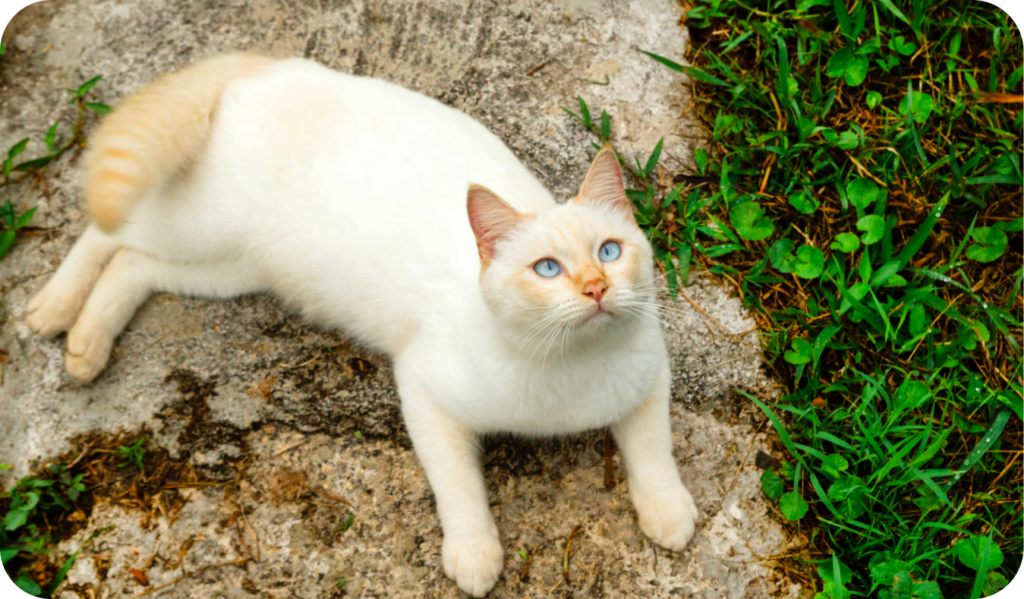
FLUTD is a common disease complex that occurs in cats of all ages. It is an umbrella term that describes multiple disease processes and clinical signs of the lower urinary tract that can appear similar to each other initially. The common signs associated with lower urinary tract disease is bloody urine, frequent urination (often small volumes), painful urination, or straining to urinate (sometimes with little or no urine produced). Animals affected by lower urinary tract disease may show some or all of these signs.
Diseases that are encompassed by the FLUTD complex are urinary tract infections, idiopathic cystitis (inflammation of the bladder without infection or other cause), urinary crystals, bladder stones, tumours of the bladder, urethral obstruction, and trauma of the urethra.
As FLUTD describes multiple disease processes, the causes of each disease type can vary a lot.
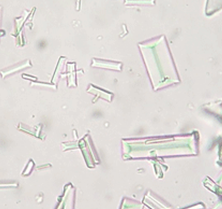
Struvite crystals in urine
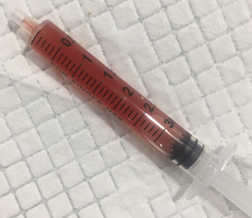
Bloody urine
Many FLUTD cases are influenced by stress, and a thorough analysis of the cat’s environment at home can identify influencing factors. Stress can appear in many forms in cats, and can be hard to recognise. The cause of the stress can be even harder to pin-point, and therefore hard to manage. Stress can come about from changes in their home environment such as visitors, owner away, new animals, stray animals outside, aggression between other animals in the household, moving house, building construction or renovations. For some, it could be something as simple as moving the furniture! Sometimes we never identify the stressful factor.
Stress can be a factor in diseases such as idiopathic cystitis, and urethral obstruction.
Diseases such as crystalluria (crystal formation in the urine) and urolithiasis (bladder stone formation) are often influenced by diet, but can also be influence by recurrent urinary tract infections.
Urinary tract infections are more common in females than in males, but can occur in any animal at any age. Diet may have some influence over the risk of infection if the urine pH is affected by nutrition. Infections are less likely to occur in acidic urine, compared to basic (alkaline) urine. Cystitis and obstructions are often reported to be more common in overweight cats.
Bladder tumours are relatively uncommon in cats, but are more likely to occur in older animals. Tumours often develop in the region where the urethra connects to the bladder, sometimes causing straining, and often causing bloody urine.

A thorough physical examination and clinical history is paramount to diagnosing lower urinary tract disease. Trying to identify environmental causes, dietary influences, and frequency of episodes is critical to diagnosis and forming a treatment plan.
Diagnosis often involves urinalysis to assess urine pH, presence of blood, white blood cells, glucose, crystals and bacteria, among other things.
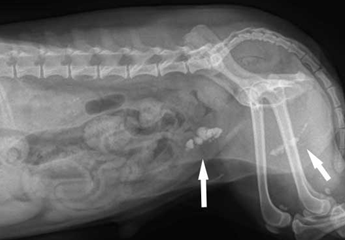
X-ray showing stones (uroliths) in the bladder and urethra of a dog
Ultrasound and x-rays may be recommended as part of urinary disease work-up to assess for tumours and bladder stones.
In some cases, a urine culture and sensitivity test may be recommended when assessing urinary tract infections. This allows for the bacteria to be grown in a lab, identified by species, then exposed to different antibiotic types to determine which ones work best. This is particularly important in cases that present with recurrent infections over extended periods of time.
Blood tests may be recommended in conjunction with urinalysis, depending on initial findings.
Treatment varies depending on the diagnosis. Urinary tract infections are often easily treated with antibiotics and pain relief as needed. Idiopathic cystitis may be treated with pain relief and modification to the environment or diet to try to manage stress. Crystalluria may be managed with urinary diets, while bladder stones usually require surgery. Treatment for each case is tailored to the animals’ presenting signs and clinical diagnosis.
The urethra is the tube that connects the bladder to the outside world. The urethra may become obstructed due to small uroliths (stones), blood clots, protein plugs, or by spasm of the urethral sphincter. If urethral obstruction occurs, the passage of urine is blocked and the bladder over-fills with urine without a means of relief. Urethral obstruction is almost exclusively seen in male cats, but can occur in females as well.
Blocked bladders are considered an emergency and are life-threatening if not treated. As the bladder continues to fill it causes extreme pain, damage to the bladder wall, increased pressure to the kidney structures, and abnormalities in electrolyte balances. If untreated, complications such as bladder rupture and permanent kidney damage can occur. Heart muscle contractions are influenced by certain electrolytes in the blood stream, and if electrolyte imbalance is not addressed then sudden death can occur due to cardiac arrest.
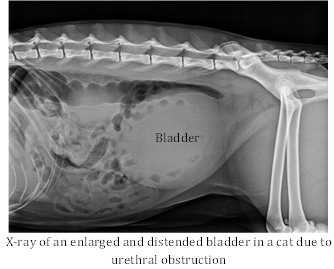
Diagnosis of urethral obstructions is often made by history of straining, absence of urine found at home, inappetence, abdominal pain, as well as many other signs. The bladder is often palpably large, hard, and painful. Blood tests are performed to assess the current health of the kidneys as well as electrolyte assessment.
Treatment for urethral obstruction involves anaesthetising the cat to allow a urinary catheter to be passed, removing the obstruction. The bladder can then be drained, and urine can be assessed. The urinary catheter is sutured in place, so it can’t be accidentally removed, and is connected to a urine collection system. The urinary catheter is left in-dwelling for 48-72 hours to
allow time for cellular regeneration of the bladder wall. Once the urine is clear and yellow again, the catheter is removed, and we then monitor for normal urination in the litter tray.
The cat must be hospitalised for the duration of treatment for urinary catheter care, IV fluid management and electrolytes, and initial medications. Some medications involved are muscle relaxants to encourage the urethral sphincter to open normally. Other medications include pain relief and antibiotics. Often dietary management is recommended using Hill’s c/d Stress diet, to reduce the likelihood of a blocked episode from occurring again.
While we endeavour to provide the best care possible with comprehensive management plans, not all cases follow the rule book and complications can occur.
In cases of urolithiasis (bladder stones), even after surgery and the recommended diet and medications have been implemented, sometimes new stones can develop that require follow-up treatment.
For urethral obstructive patients, repeat episodes can occur despite our best efforts. For cats that present with urethral obstructions repeatedly, other treatment options may be recommended. Sometimes surgery to widen part of the urethra, known as a perineal urethrostomy, is recommended to reduce the risk of repeated obstructive episodes. This procedure can be done with a specialist surgeon. However, some very rare cases can still experience bladder obstruction despite a perineal urethrostomy.

